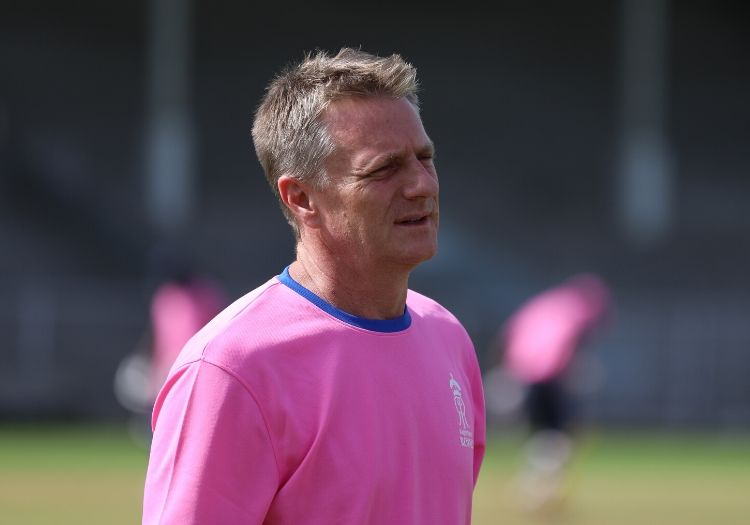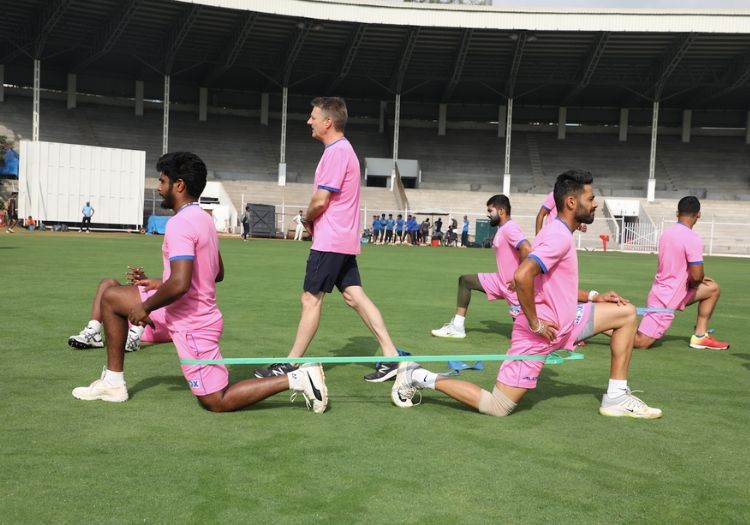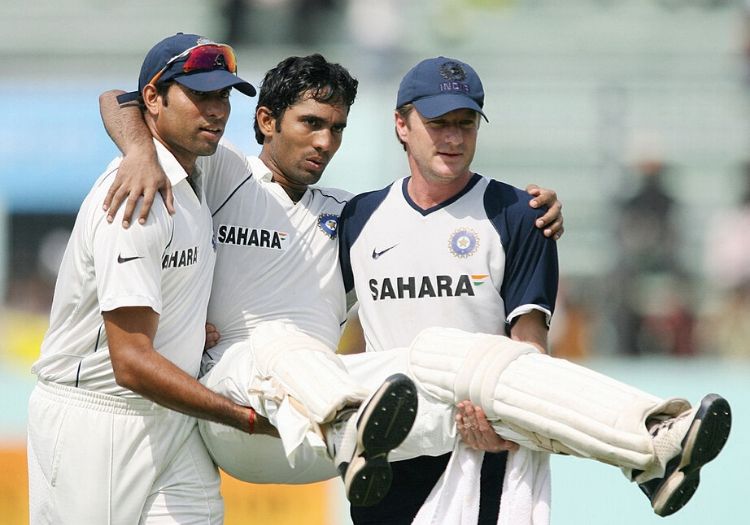Rajasthan Royals physio John Gloster, who has previously worked with Surrey and the Indian national side, tells The Cricketer how professional players will be challenged both physically and mentally by the impact of the COVID-19 pandemic

There are certain things that we cannot control in the current climate, but there are also things that we need to control and we can do so.
We can liken this a little bit to T20 cricket in a way in that all of us now – both as clinicians and also as players – we need to be creative, we need to be smarter, we have to have proactive plans in place. But also, with a little bit of Test cricket mixed in as well – we have to be patient and in it for the long run. There’s going to be an element of endurance to this as well.
How do we look at the physical environment while being in the constraints of quarantine? We’re effectively all in some kind of quarantine at the moment, being in isolation. We know that exercise is one of the greatest immunity-boosters of all. How do we implement that around the constraints that we have?
This is where the creativity side of it comes in – the T20 mindset. Our body is, in fact, a gymnasium in itself. We are going back to a lot of the old bodyweight-type training, repetitive-type training. We’re looking at going back to some traditional yoga practices.
Through technology, we’re able to push a lot it out to them in that form as well. I have seen some fantastic stuff coming out of Ben Stokes’ Instagram in recent days – he’s been really proactive.
But as and when cricket does get back up and running, there has to be a transition period. Everyone will be on the same page, pretty much. In terms of match fitness, nobody has been playing.
Often people come to the IPL at two ends of the spectrum – they’ve either played too much cricket or not enough. Our job before the IPL starts tends to be spending 10 days finding out who’s where and then evening them all out again.
Now, the same job will have to happen again. The difference is that everybody will be in the same place. The strategies will be very similar. It will have to be at least a couple of weeks before competition can begin. We’re talking match-play, simulation. But then again, you can’t throw someone straight into a match simulation without some basic physical preparation as well.
The biggest killer for these guys is going to be the lack of high-speed running, because that’s what the modern game is all about and that’s where the most injuries occur – when there’s a drop-off in high-speed running. The main protective mechanism for injury these days in the T20 form is high-speed running loads. The difference between T20 and Test cricket in terms of high-speed running loads is about 40 per cent.

Gloster is physio at the Rajasthan Royals franchise
Anybody who’s coming from Test cricket to T20, we know that they’re at risk of injury because they don’t have the loads in their legs. The potential for them to injure is high.
It’s very similar here. They’ll be coming from zero and then expected to be going straight back to very high levels of high-speed running. That would be the greatest risk I can see, given the physical constraints that they have.
The other area we need to be really mindful of is the mental state side of it. We’ve suddenly taken these guys away from six to eight hours a day of being physically active in structured nets and physical environments to a constrained environment. There’s probably as big a psychological play here as a physical play.
We need to make sure that there are resources and appropriate people available to them to access and explore this side of their game as well. We often think that the mental conditioning coach only plays a role in the tournament and in high-pressure situations of the game scenario.
In fact, this is probably a greater stress environment for them than their game environment. There’s the fear of the unknown and there’s nothing worse for an athlete than a fear of the unknown.
I think this is a critical piece that we have to look at closely, because there is a fear of the unknown at the moment amongst all of us in every country – we’re not isolated from that. Are they playing games at home? Are they stimulating their minds? Are they playing board games with their kids? What are the other things that they’re doing that they’re biding time with?
The physical stuff, I think, is very obvious and they’re really good at that. They just have to be a bit smarter in terms of how they do that in the constraints of their own home – using stairs and whatever else they have around the house that they could use as a gymnasium.
My job as physio at Rajasthan Royals is also to add a bit of realism. I’ve had so many messages come to me. Steve Smith messaged me the day before yesterday, asking what I realistically thought was going to happen. Sanju Samson was on the phone a couple of days ago.
Some of these guys are desperate to play, which I think is amazing. But at the same time, you have to be realistic about this and say: ‘Well, this is something that none of us have ever experienced before. I can’t give you dates but I can ensure that when the time comes, you are both physically and mentally ready.’
.jpg)
Steve Smith leads Rajasthan, with Jos Buttler, Ben Stokes, Jofra Archer and Tom Curran also among the team's overseas players
I had four years with Surrey in county cricket; it’s a bit like one of those rain delays, where you don’t know when you’re going to get back out there but you have to be ready within five minutes to be on the field. That’s a mental game, but there’s also a physical element to that. You have to be warmed up.
I was there in the late 1990s, so I’m saying: ‘What would Martin Bicknell be doing now?’ Okay, he would be thinking through what he’s going to bowl to this guy. He’d be doing his warmup in the corner like he always does.
We have to be prepared but we don’t quite know when we’re going to be able to utilise that preparedness. I’m using that example to a few of the guys – sitting in the dressing room on a wet day in the UK. They are learnings that a lot of these guys have already had, but in an entirely different environment.
Managing that desperation to play is paramount. This is how a lot of these guys express themselves. There are a lot of unique characters; it might hit Steve Smith harder than it might hit Cheteshwar Pujara, for example. It might hit Steve harder than Jofra Archer, who knows how to chill and to take his time out. He doesn’t have to be physical all the time.
There are different characters who you can highlight among different teams around the world who are probably better suited to this situation than perhaps others are.
But that’s only once you get to know their mindsets. I can guarantee you that a big part of Ben’s game is physical, so he will be focused a lot on the physical aspects, which is brilliant. Steve will be trying to do something all the time to keep himself busy, and that will most likely be physical or it will be with a bat and ball in his hands on some level. These guys itch to have a piece of wood in their hand or a bit of leather.
For some personalities, this may become a big issue, the longer we’re constrained to these constricted environments. I see that as a really important part of this: the physical, they know; this is the part of their game they probably don’t know as well. One of the great learnings they’re going to take out of this is actually how to work, manage and control their minds a lot better.
You have to take positives out of any bad situation. If it’s injury, what are you going to learn from this injury? For these guys, perhaps the messaging could be that it’s a brilliant chance to work on the mental side of their game. To get through this, you’re going to have to. They could come out of this as much stronger cricketers anyway, much stronger athletes, much stronger people.
I think you’ll find a lot of these players will find other ways to escape. The biggest issue I’ve seen with the modern cricketer is that most of them don’t know how to escape cricket. They don’t know how to escape and properly switch off from cricket and to allow their mind to rest.

Gloster (right) previously worked as physio for the Indian national team
Rahul Dravid was brilliant; he would read. Others go and watch movies. Guys found ways to get away from cricket, switch off, mentally relax and be ready when they came back to the game.
One area that we can control – not only for their health but also for their performance – is the whole concept of nutrition and looking at how we manage that within these times, particularly so because we’re now exercising less for a period of time.
Being a lot smarter about what we eat and when we eat, particularly in terms of immunity, there are a lot of food groups that we should be really drilling down on and focusing on and ensuring we’re getting more of.
Immunity has become such an important thing. That’s critical to most athletes anyway, but I believe we have to be a lot smarter and really be clued up on what food groups we should be eliminating from their diets and what should we be bolstering their diets with.
Processed foods and sugars have to go out of the window: one, to keep their weight down; two, to keep their immunity status up and keep their inflammatory status down.
At the end of the day, there’s a big issue at hand that we have to address now, but all of these are strategies that can be taken forward to improve their game when we go back to playing. I see a lot of valuable lessons and learnings that they can take from this period and take forward.